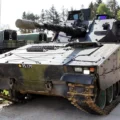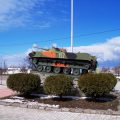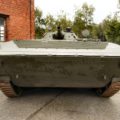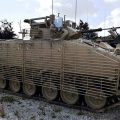
Blindés de protection Lang HS.30 | |
|---|---|
| Pays | Allemagne de l’Ouest |
| Type | Véhicule de combat d’infanterie |
| Période | Années 1950 |
| Construit | 2000+ |
Lla Blindé de tir Lang HS.30 (également Schützenpanzer 12-3) était un véhicule de combat d’infanterie ouest-allemand développé dans les années 1950. Il s’agissait d’un design suisse Hispano-Suiza, avec un moteur Rolls-Royce. Après quelques premiers problèmes mécaniques, seulement quelques 2000 ont été construits sur les 10 000 prévus. Il était armé d’un canon de 20 mm qui était une arme exceptionnellement puissante pour un véhicule blindé de transport de troupes de l’époque. Sa conception s’est avérée avoir de nombreux défauts et inconvénients et la construction a été suivie d’un grand scandale politique en Allemagne de l’Ouest dans les années 1960. 2176 SPz 12-3 et des variantes ont été construites jusqu’en 1962, pour lesquelles le gouvernement allemand a payé 517 millions de DM, soit environ 238 000 DM par véhicule. Le SPz 12-3 a été déployé pour la première fois en 1958 et a été remplacé par le véhicule de combat d’infanterie Marder à partir de 1971
| Schutzenpanzer Lang HS.30 Se promener | |
|---|---|
| Photographe | Vladimir Yakubov |
| Localisation | Musée militaire du sud de la Nouvelle-Angleterre |
| Photos | 79 |
| SPz Lang HS-30 Promenade autour | |
|---|---|
| Photographe | Inconnu |
| Localisation | Inconnu |
| Photos | 30 |
Voir aussi :
Lla Blindés de protection Lang HS.30 was a West German infantry fighting vehicle that entered service in 1960. It was designed by the Swiss company Hispano-Suiza, and had a 20 mm HS 820 autocannon as its main armament. The HS.30 was intended to provide fire support and mobility for the mechanized infantry units of the Bundeswehr, and to fight alongside tanks in both offensive and defensive operations. The HS.30 had a low profile, a torsion bar suspension, and a Rolls-Royce B81 petrol engine that gave it a top speed of 58 km/h.
However, the HS.30 also suffered from many technical problems and reliability issues, such as engine overheating, transmission failures, and poor quality control. The HS.30 was also involved in a political scandal in the 1960s, when it was revealed that the German government had paid a much higher price than originally agreed for the vehicle, and that there were irregularities and corruption in the procurement process. The HS.30 was gradually replaced by the more modern and effective Marder infantry fighting vehicle from 1971 onwards, and was phased out of service by the 1980s.
Vues : 3195







